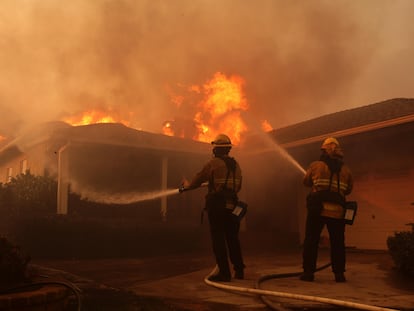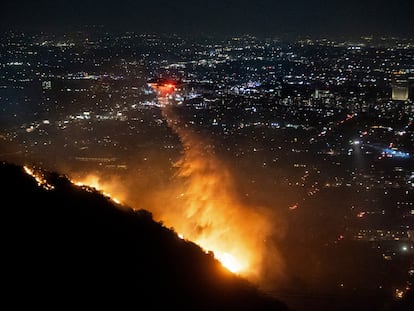The fire that destroyed ‘California Dreaming’: ‘We knew this was going to happen sooner or later’
The Los Angeles wildfires remain uncontrollable after three days, with over 180,000 people evacuated and nearly 10,000 buildings destroyed. The largest blaze, the Palisades Fire, has ravaged 8,100 hectares of one of California’s most scenic enclaves. EL PAÍS speaks with the victims
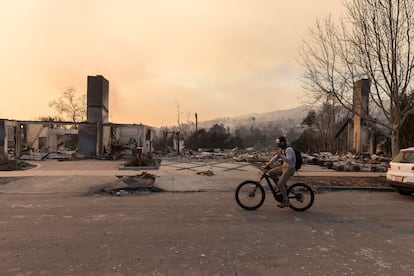
Pacific Palisades is gone, but its community is not. When Chris Babcock arrives at the ruins of his house on Las Lomas Street, he calls out to Steve Eckhoff, his neighbor, from across the avenue. The two men, now in their fifties, approach and share a heartfelt yet brief embrace.
“We’re in the same boat. We’re safe and sound — that’s all that matters,” Babcock says.
It’s Thursday afternoon, and it’s been almost two days since they evacuated their homes, which stood just 20 meters from each other. When they fled, driven out by the relentless Palisades fire that has scorched 8,100 hectares of some of the most iconic terrain on the West Coast of the United States, their homes were still standing. Now, all that remains is a field of smoky flames, rubble, and nails.
At the Babcock home, the chimney still stands. At the Eckhoff home, not even that.
“Many people ask if I’m going to rebuild,” Babcock says. “I will — but only if I have the same neighbors.”
The Palisades Fire was the first to ignite in Los Angeles, and within days, it became the most destructive blaze in the city’s history. Los Angeles is currently battling four other fires simultaneously — and with limited success. As of now, the Palisades Fire is only 6% contained.
This devastating wave of fires has claimed 10 lives, with at least half of the victims killed in the eastern fire, known as the Eaton, another major front that firefighters are struggling to control. Authorities fear the death toll could rise in the coming days, once the emergency is over and the clean-up begin. The full extent of the damage also remains uncertain, with current estimates exceeding 10,000 destroyed buildings — figures derived primarily from aerial surveys. The fires have largely destroyed homes.
Entire neighborhoods in Pacific Palisades have been reduced to rubble. Some streets were spared, while others are barren, with not even a single tree left standing. The uncontrollable fire destroyed at random.
Walking through the fire-ravaged area is like traversing a war zone. For many homes, only the house numbers etched on the sidewalks remain as markers of what once stood. Chris Babcock’s house, at 665 Las Lomas, has been reduced to the same pile of ruins as his neighbors’.
Babcock had lived in the neighborhood since 1972 and called that house home for more than three decades. He fled in haste with his wife and their dogs, leaving behind his car collection. An Audi Quattro was lost to the flames, while another car, parked on the street, was miraculously spared.
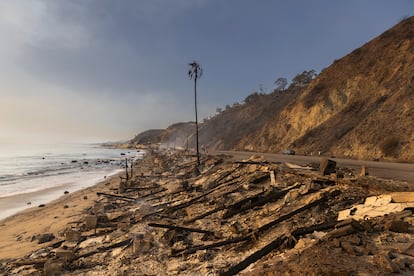

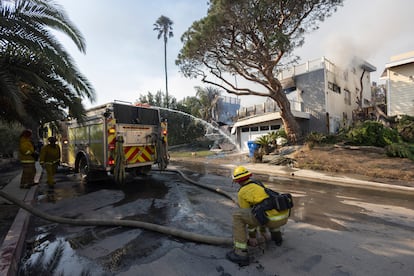
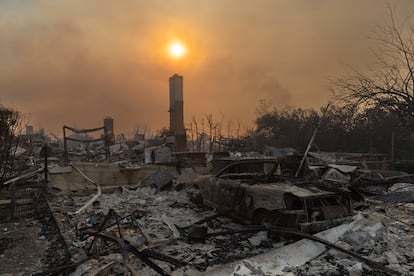
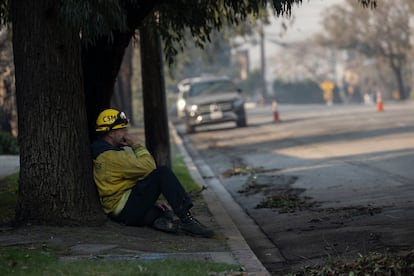
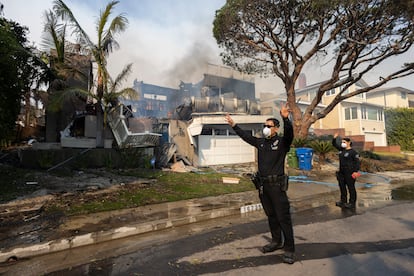
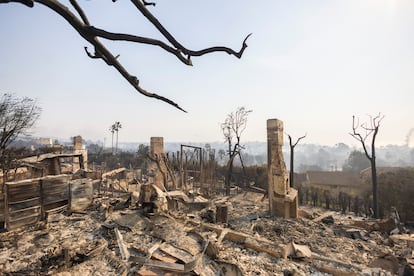

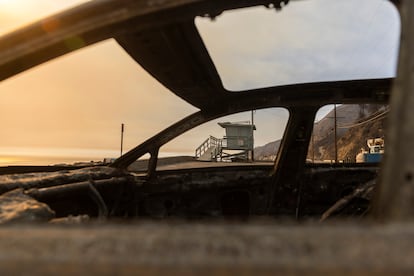
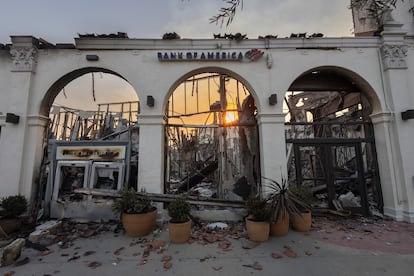
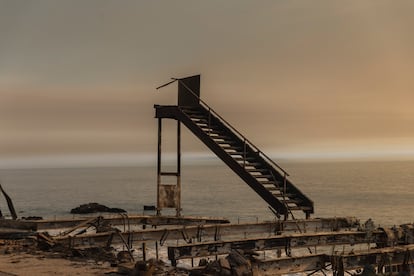
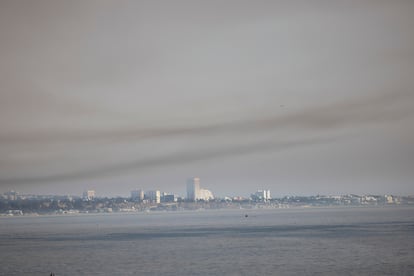
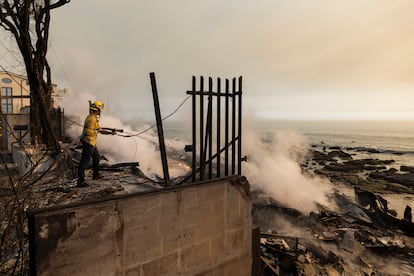

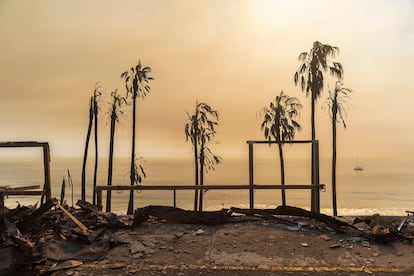
“This is unprecedented,” says someone who has witnessed many fires up close. Nothing compares to this week, when hurricane-force winds swept from the interior to the coast, igniting an area that had long been a ticking time bomb.
“Look at those trees over there — they’re a danger,” Babcock says, gesturing toward a tall, charred specimen that still stands. “Building house after house for 80 years has made everything so concentrated. Combine that with overgrown vegetation and flat terrain, and everything was primed to burn. The firefighters didn’t stand a chance — against winds like that, it was impossible. They couldn’t even move through such narrow streets,” he explains.
Another problem was the prolonged fire season, which traditionally ends in September but now stretches into the new year with almost no rain. “This is a tragedy. Nothing like this has ever happened before, but we felt this was going to happen sooner or later,” he admits.
Babcock’s only regret is that he and his neighbors never bought a plane to air drop water. “We rented one twice a year, but if you rent it for four years in a row... well, at sooner or later, it’s better to just buy it,” he says, maintaining a surprisingly good-humored tone despite the devastation.
This morning, many residents have climbed the hills of Temescal to see the scale of the disaster with their own eyes. “This reminds me of the photographs from World War II,” says Brian Lallment, 71. He came to see if the house where he grew up and where his 92-year-old mother still lived was still standing.
With optimism, he climbed Jacon Way. There were few houses in perfect condition, but when he reached 664 he found only ashes. “That house is standing, that house is standing... and we are screwed,” he says in perfect Spanish, a language he learned from his Venezuelan ex-wife.
He recognized what was left of his home because he found the seashells he had collected during his travels on scientific research ships. The amethyst stone he brought from Brazil, and which he managed to keep after his first divorce, changed its bright colors to ash.
Lallment’s parents moved to Pacific Palisades in 1959, settling in a community established a century earlier by Methodists who envisioned the hills as the ideal spot for a commune. They paid $39,000 for the one-story, 2,200-square-foot house — a sum equivalent to $420,000 today with inflation.
“My father thought he’d never make back that investment,” Lallment reflects, “and look what it’s become.” Before the fire, the property was worth $2.5 million.
The area became a haven for Jews fleeing persecution in Europe, drawing cultural icons like writer Thomas Mann, who gave the community its nickname, “Weimar by the Sea.” Over time, Pacific Palisades also became home to luminaries such as designers Charles and Ray Eames and architect Richard Neutra. Its secluded, hilly terrain made it a magnet for celebrities seeking privacy, some of whom also lost their homes in the fire. Among them were Billy Crystal, Paris Hilton, and the acting couple Adam Brody and Leighton Meester, who lived just meters from Brian Lallment’s mother.
The late Matthew Perry, actor of Friends, once owned a house in the neighborhood, though it was sold to an investor years ago. The property survived largely unscathed in one of the few areas that suffered little damage.
Unlike the celebrity homes, the Lallment residence was a quintessential example of 1950s architecture: an elegant, sturdy brick chimney and red oak floors. As was typical of American homes of that era, it was built primarily from wood, a material that could be swiftly imported from Canada through the port of Long Beach and used to construct entire homes in just days.
The problem, as this fire tragically revealed, is that wood is highly flammable — especially under the extreme conditions seen this week. Winds capable of carrying embers two miles, combined with the lowest humidity levels since 1962, created the perfect storm for an inferno that has devastated one of Los Angeles’ most exclusive neighborhoods.
Blow to Los Angeles
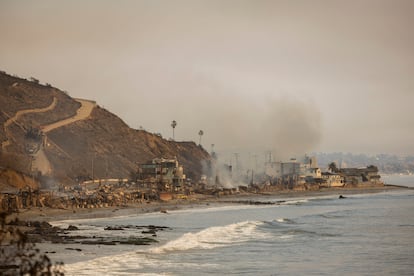
Driving down the coast from Pacific Palisades, a 15-minute journey reveals the sparkling Pacific Ocean. To the left lies Santa Monica, a city still under evacuation orders that have displaced more than 180,000 people. To the right is Malibu, a community synonymous with California’s dreamlike image: endless, curving highways, beachfront homes, swaying palm trees, salt-kissed restaurants, and breathtaking sunsets. That’s now gone. Those million-dollar homes and bungalows have been destroyed by the Palisades Fire.
The palm trees are now long, charred sticks. From the mountains to the beach, all that can be seen is smoke and, from time to time, flames in certain areas. The coastline is all that remains, though the ocean is stained brown with ashes and debris from the fires. No one will dine at Moonshadows, the renowned restaurant with spectacular Pacific views from its glass porch, because it no longer exists. It has been completely consumed by flames, down to its foundations, leaving only the outline of its parking lot.
The iconic blue lifeguard huts are empty, and the beaches are deserted, with no bathers or surfers to watch over. The Pacific Coast Highway is closed, with nothing to see but devastation and ruin. Only time will reveal how long it will take Malibu to rise from its ashes.
The famous blue huts are empty of lifeguards these days, but the beaches are also empty of bathers and surfers to watch over. Passage through the area, along the famous Pacific Coast Highway, is closed: there is nothing to see here but devastation and horror. Only time will tell how long it takes Malibu to rise from its ashes.
Sign up for our weekly newsletter to get more English-language news coverage from EL PAÍS USA Edition
Tu suscripción se está usando en otro dispositivo
¿Quieres añadir otro usuario a tu suscripción?
Si continúas leyendo en este dispositivo, no se podrá leer en el otro.
FlechaTu suscripción se está usando en otro dispositivo y solo puedes acceder a EL PAÍS desde un dispositivo a la vez.
Si quieres compartir tu cuenta, cambia tu suscripción a la modalidad Premium, así podrás añadir otro usuario. Cada uno accederá con su propia cuenta de email, lo que os permitirá personalizar vuestra experiencia en EL PAÍS.
¿Tienes una suscripción de empresa? Accede aquí para contratar más cuentas.
En el caso de no saber quién está usando tu cuenta, te recomendamos cambiar tu contraseña aquí.
Si decides continuar compartiendo tu cuenta, este mensaje se mostrará en tu dispositivo y en el de la otra persona que está usando tu cuenta de forma indefinida, afectando a tu experiencia de lectura. Puedes consultar aquí los términos y condiciones de la suscripción digital.
More information
Archived In
Últimas noticias
Families demand repatriation of bodies of Colombians who died in Ukraine: ‘This war is a slaughterhouse for foreigners’
James Cameron: ‘For the films I like to make to continue to exist, we have to find a way to make them cheaper’
Helen Levitt, the photographer who captured the theater of the everyday
The guardians of the meteorites of the Argentine Chaco
Most viewed
- Christian Louboutin: ‘Young people don’t want to be like their parents. And if their parents wear sneakers, they’re going to look for something else’
- US sanctions against jailed cartel leader ‘El Marro’ highlight Mexico’s lack of control over its prisons
- Cartels in Mexico take a leap forward with narco-drones: ‘It is criminal groups that are leading the innovation race’
- Liset Menéndez de la Prida, neuroscientist: ‘It’s not normal to constantly seek pleasure; it’s important to be bored, to be calm’
- ‘El Limones’ and the growing union disguise of Mexican organized crime
